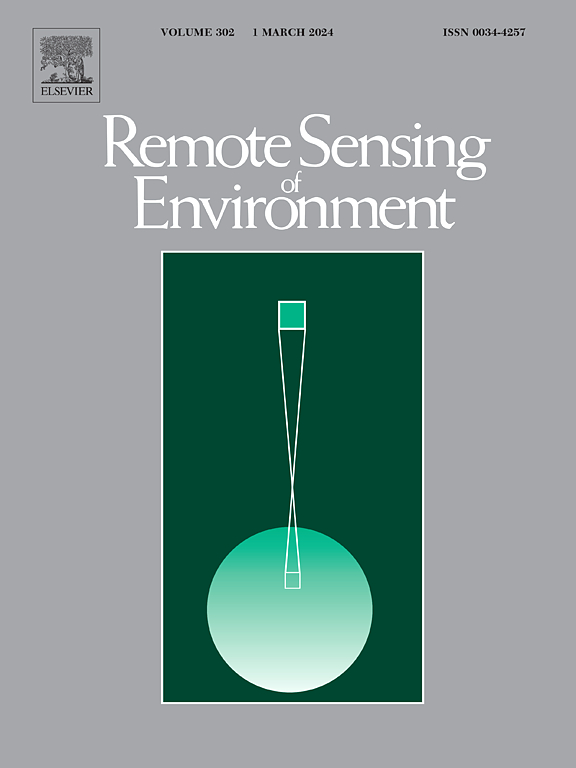MODIS积雪反照率制图方法评价
IF 11.4
1区 地球科学
Q1 ENVIRONMENTAL SCIENCES
引用次数: 0
摘要
我们将5个每日modis衍生的雪反照率产品与来自美国加利福尼亚州和科罗拉多州站点的地形校正的原位数据以及来自加利福尼亚州和科罗拉多州几个盆地的航空高光谱影像的雪反照率进行了比较。我们考虑的MODIS衍生产品是NASA标准产品MOD10A1, MCD43A3和MCD19A3D,以及STC-MODSCAG/MODDRFS和MODIS SPIReS。这些产品的检索算法各不相同,包括对于混合像素,它们是代表像素内的雪的反照率还是代表整个像素的反照率。与原位数据相比,STC-MODSCAG/MODDRFS和SPIReS产品具有最高的精度(RMSE≤0.093)和最完整的时空数据记录(~ 99%),因为每种算法都独立开发了间隙填充和插值方法。MOD10A1和MCD43A3产品低估了积雪反照率(RMSE≤0.248),因为它们将非积雪地表纳入其计算中,并且由于雪探测精度较低和缺乏插值,数据记录不完整(~ 76%)。MCD19A3D产品的精度与STC-MODSCAG/MODDRFS和SPIReS相似(RMSE = 0.090),但在所有数据集中数据完整性最低(56%)。在将MODIS产品与机载高光谱数据进行比较时,我们发现了类似的性能趋势。我们的分析表明,考虑到部分积雪覆盖并结合所有可用光谱信息的算法可以产生最佳的积雪反照率产品,跨越时间和空间。将类似算法应用于高光谱数据,可以更好地分解光谱特征,检索雪的光学特性;因此,我们可以期望从未来的高光谱卫星任务中获得积雪反照率的改进。本文章由计算机程序翻译,如有差异,请以英文原文为准。
Assessment of methods for mapping snow albedo from MODIS
We compare five daily MODIS-derived snow albedo products to terrain-corrected, in situ data from sites in California and Colorado, USA, and to snow albedo derived from airborne hyperspectral imagery over several basins in California and Colorado. The MODIS-derived products we consider are NASA standard products MOD10A1, MCD43A3, and MCD19A3D, along with STC-MODSCAG/MODDRFS and MODIS SPIReS. These products vary in their retrieval algorithms, including whether, for mixed pixels, they represent the albedo of snow within the pixel or the albedo of the whole pixel. When compared to in situ data, STC-MODSCAG/MODDRFS and SPIReS products have the highest accuracy (RMSE ≤0.093) and most spatially and temporally complete data records (∼99 %) because the algorithms each have independently developed gap filling and interpolation methods. The MOD10A1 and MCD43A3 products underestimate snow albedo (RMSE ≤0.248) because they incorporate non-snow land surfaces into their calculations and have less complete data records (∼76 %) due to less accurate snow detection and lack of interpolation. The MCD19A3D product has accuracy similar to STC-MODSCAG/MODDRFS and SPIReS (RMSE = 0.090) but the lowest data completeness of all datasets (56 %). We found similar performance trends when comparing the MODIS products to airborne hyperspectral data. Our analysis shows algorithms that account for fractional snow cover and incorporate all available spectral information result in the best snow albedo products across time and space. Similar algorithms applied to hyperspectral data can better resolve spectral features to retrieve optical properties of snow; hence we can expect improvements in snow albedo retrievals from future hyperspectral satellite missions.
求助全文
通过发布文献求助,成功后即可免费获取论文全文。
去求助
来源期刊

Remote Sensing of Environment
环境科学-成像科学与照相技术
CiteScore
25.10
自引率
8.90%
发文量
455
审稿时长
53 days
期刊介绍:
Remote Sensing of Environment (RSE) serves the Earth observation community by disseminating results on the theory, science, applications, and technology that contribute to advancing the field of remote sensing. With a thoroughly interdisciplinary approach, RSE encompasses terrestrial, oceanic, and atmospheric sensing.
The journal emphasizes biophysical and quantitative approaches to remote sensing at local to global scales, covering a diverse range of applications and techniques.
RSE serves as a vital platform for the exchange of knowledge and advancements in the dynamic field of remote sensing.
 求助内容:
求助内容: 应助结果提醒方式:
应助结果提醒方式:


